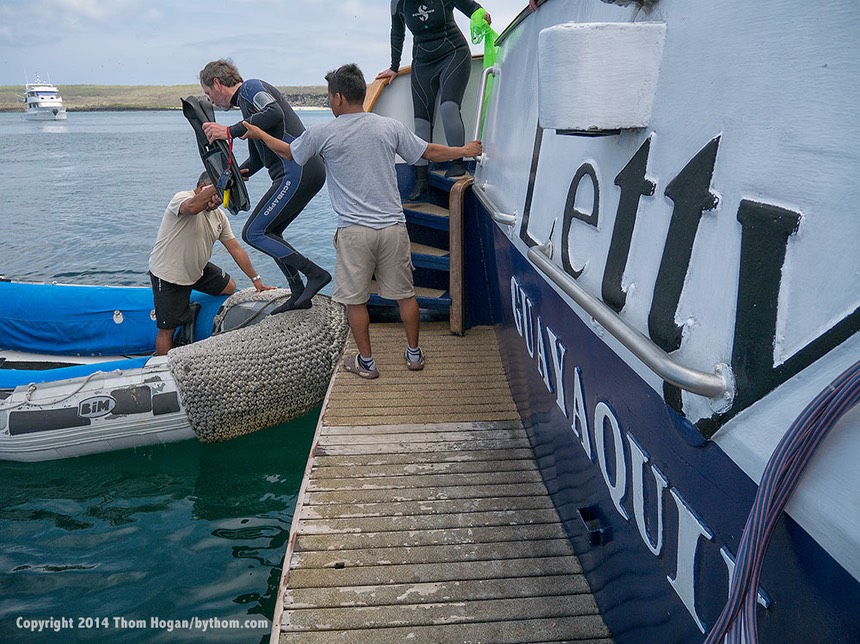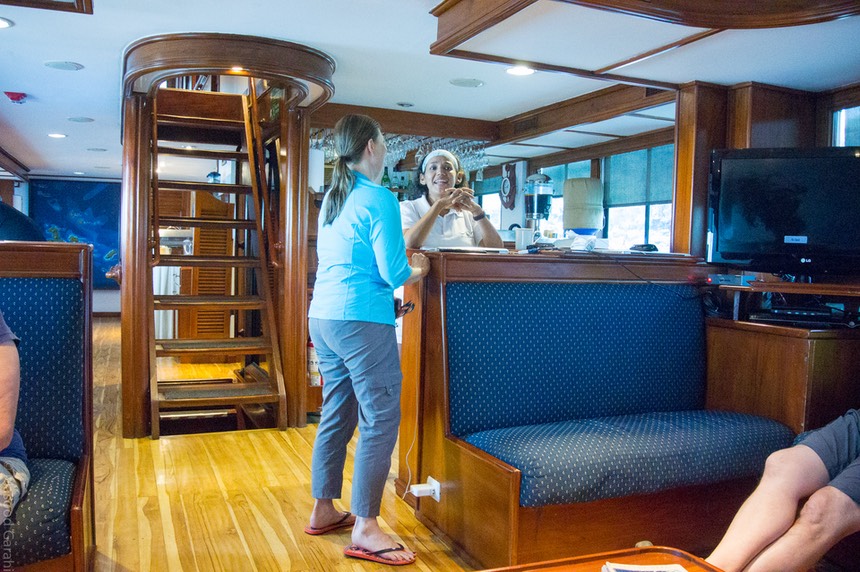At present, there are 93 boats registered with the park service that are hosting trips through the Galapagos National Park. Of those, most only carry 16 passengers, or, as in the case of the boat we’re on, the Letty, a maximum of two groups of 10 passengers.


A handful of large capacity cruise-type ships prowl the waters, most notably the National Geographic ships. These large vessels start at 48 passengers and go up to 100 passengers. Currently that includes the Eclipse, Galapagos Explorer II, Galapagos Legend, La Pinta, National Geographic Endeavor, National Geographic Islander, Santa Cruz, and the Xpedition. Not all of these big boats tend to be working the waters at the same time; some do cruises elsewhere, as well.
Some boats are shorter, multi-floored motor-only boats (the Letty is one), others are motor sailors. Next year’s trip will be on the Mary Anne, a 216-foot three masted sailor that is really set up to handle 32 people, but only books 16. [Sponsored link: Wilderness Travel uses the Mary Anne for most of their trips. Tell ‘em Thom sent you and I might get a brownie next time I visit the offices. ;~]
So some boats are a little tighter and cozy, while others are big enough that you can find space where others can’t find you. The difference in boats makes more of an impact if you’re, say, a family of five just out to vacation together. The smaller boats will have in you in close quarters with others. For a workshop, though, it’s not as important, as long as everyone is participating in the workshop: cozy actually means more interacts photographically. You can learn from other students as well as instructors.
The big National Geographic boats and the like are more like “cruises.” Dining for 16 is a lot different than dining for 48 or more. The NG boats tend to have multiple experts who give presentations on various scientific and historical aspects of the islands.
Each boat has assigned visitation sites by the park service on what is called a tourism patent. While there are about 74 active land sites, some additional sites are closed to let animals get some rest from the tourists or for feral animal removal, while others have tougher restrictions on the number of boats that can be there at a time. The park service is trying to balance the tourism load across the park, while still providing enough access to tourism so that you can see a wide variety of animals, geology, and plant life. 66 boats do the basic cruise we did. There are also 9 boats doing daily tours, 23 boats doing daily dive tours, and 7 boats doing multi-day dive tours. Each boat has a fixed schedule, which you can see on this page.
If you want to see the visitation site details, go to this National Park page and click on the Visitor Sites Guide in the middle of the page.
Most boats are running one week cycles for what is a two week itinerary. So they pick up their passengers from one of the two airports on, say, a Saturday and return them to that airport the following Saturday. If you’re on a slower boat, that may mean that you don’t get out to the extremes (such as Genovesa). Even if you’re on a faster boat, your one-week cruise will consist of a small subset of what the Galapagos has to offer. The tour company might refer to that subset as “Northern Islands” or “Western Islands” or “Central Islands” or “Southern Islands”, and so on, which gives you a general flavor of your boat’s destinations for the week.
My workshop is two weeks for a reason: it allows us to hit pretty much everything people would want to see, and it maximizes what the boat you’re on can do (i.e. you’re seeing both halves of their two-week cruise schedule). In total, we hit about half what’s available to non-divers. Because of park limitations on usage, the odd island out on our trip is Santa Fe, but we’re touching pretty much all the other places I’d want to be when photographing in the islands.
Most of the boat crews run on eight week working schedules: eight weeks on, four weeks off. On our crew we’ve got a mix of those from San Cristobal, Puerto Ayora, Guayaquil, and Quito. You can always tell when we’re near an island with a cellular signal: the crew tries to squeeze in a few minutes of talk with their family. While eight weeks away from home is a tough life, it’s also one that pays relatively well, especially when the tourists tip well. It would be hard for some of the crew to support their families as well as they do if they had to take jobs back in Guayaquil.
Obviously, the ones that live on the islands get chances to pop into town during the cruises. For instance, Ronald, our waiter and bartender, went into town to spend some family time this afternoon (I’m writing this at Puerto Ayora). But for those whose families are back on the mainland, they have to rely upon phone contact only, and intermittent contact at that.
Naturalists have to train at many things and pass tests to be selected from the best candidates, though there is an active program to help those that grew up on the islands to study for becoming a naturalist. At the moment there are about 400 certified naturalists. If you’re doing the math (400 * 16 = 6400 tourists/week, which would put the tourism at over 330,000 a year, more than twice what it likely is) obviously they aren’t all working all the time. There’s great competition to get on the best boats and have the best schedules.
Cecibel and Billy are our two naturalists, both Class III, I believe (there are three classes, with III being the highest):

Both Ceci and Billy are long term veterans in the Galapagos, with over two dozen years of naturalist guiding between them. Besides their constant smiles—who wouldn’t be smiling with this job?—they were great ambassadors for the islands: full of useful and interesting knowledge, gentle in spirit and ever helpful, proud stewards of their park, and as it turned out, really great snorkelers.
You can find out more about the Naturalist Guide program on this park service page. Guides fill out reports for every trip, and evaluate one another as well as incidents or problems that they spotted during the trip. They’re really the daily eyes and ears of the park service in terms of monitoring the health and quality of each of the visitation sites.
To learn about current research at Charles Darwin Station or to donate to help further that research, visit the Charles Darwin Foundation page.
Yes, this was a little break from the animals, and tomorrow will be another soft day as we are in port to restock supplies and get the boat ready for week two. But trust me, week two will have even more of the photography that I hope you enjoyed in week one, as we visit the Southern and Eastern islands in the archipelago.
